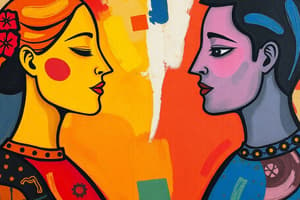Podcast
Questions and Answers
What does the term 'markedness' refer to in the context of language?
What does the term 'markedness' refer to in the context of language?
- The relationship between language and power dynamics
- The privileging of masculine terms as the default (correct)
- The way language embodies gender stereotypes
- The inherent traits that define gender roles
Which concept emphasizes that gender is enacted through behaviors and language rather than being innate?
Which concept emphasizes that gender is enacted through behaviors and language rather than being innate?
- Differentiation theory
- Performative nature of gender (correct)
- Indirect indexicality
- Asymmetry
How does Cameron view the relationship between language and societal norms?
How does Cameron view the relationship between language and societal norms?
- Language both reflects and reinforces power structures in society (correct)
- Language remains static and unaffected by societal changes
- Language merely reflects individual identity without societal influence
- Language has no impact on social interactions or dynamics
What is a primary criticism of Cameron's work regarding gender and language?
What is a primary criticism of Cameron's work regarding gender and language?
What does 'indirect indexicality' explore in gendered language?
What does 'indirect indexicality' explore in gendered language?
In what way is gender described in relation to socialization according to the content?
In what way is gender described in relation to socialization according to the content?
What does the concept of asymmetry indicate in gender roles?
What does the concept of asymmetry indicate in gender roles?
What are simplified gender ideologies often characterized by?
What are simplified gender ideologies often characterized by?
How do cultural differences affect gender categories?
How do cultural differences affect gender categories?
What is a common misconception about African-American English (AAE)?
What is a common misconception about African-American English (AAE)?
Which statement best describes the relationship between language and race?
Which statement best describes the relationship between language and race?
What do anthropologists argue about race?
What do anthropologists argue about race?
Which aspect of language can perpetuate covert racism?
Which aspect of language can perpetuate covert racism?
What is an example of a linguistic feature in AAE?
What is an example of a linguistic feature in AAE?
What does code-switching demonstrate among AAE speakers?
What does code-switching demonstrate among AAE speakers?
Which statement reflects a misconception about race?
Which statement reflects a misconception about race?
What does the concept of performative gender identity suggest about gender?
What does the concept of performative gender identity suggest about gender?
How do ideologies regarding gender roles persist in society, despite empirical research challenging them?
How do ideologies regarding gender roles persist in society, despite empirical research challenging them?
Which statement best reflects the asymmetrical nature of gender roles?
Which statement best reflects the asymmetrical nature of gender roles?
What is a key characteristic of the collaborative view of gender?
What is a key characteristic of the collaborative view of gender?
In the context of gendered language, how does the Kiswahili language differ from English?
In the context of gendered language, how does the Kiswahili language differ from English?
What is the implication of claiming that behaviors such as talkativeness are learned rather than biologically determined?
What is the implication of claiming that behaviors such as talkativeness are learned rather than biologically determined?
What is a significant critique of traditional notions of masculinity, particularly regarding toxic masculinity?
What is a significant critique of traditional notions of masculinity, particularly regarding toxic masculinity?
How do language and power dynamics relate to gendered communication?
How do language and power dynamics relate to gendered communication?
Flashcards
Markedness (Language)
Markedness (Language)
The concept in language where one form (usually masculine) is the default, and other forms (usually feminine) are considered different or marked.
Indirect Indexicality
Indirect Indexicality
How language styles can signal gender norms and reinforce gender stereotypes.
Performative Nature of Gender
Performative Nature of Gender
Gender is not innate; it's something done or performed through actions, language, and behavior.
Asymmetry (Gender)
Asymmetry (Gender)
Signup and view all the flashcards
Empirical Approach (Gender & Language)
Empirical Approach (Gender & Language)
Signup and view all the flashcards
Socialization and Context (Gender)
Socialization and Context (Gender)
Signup and view all the flashcards
Learned Gender
Learned Gender
Signup and view all the flashcards
Gossip as Gendered Practice
Gossip as Gendered Practice
Signup and view all the flashcards
Race: Biological or Social?
Race: Biological or Social?
Signup and view all the flashcards
AAE: Sloppy or Rule-Governed?
AAE: Sloppy or Rule-Governed?
Signup and view all the flashcards
Language: Reflecting Racism
Language: Reflecting Racism
Signup and view all the flashcards
Greater Variation Within Races
Greater Variation Within Races
Signup and view all the flashcards
Gradual Variation in Traits
Gradual Variation in Traits
Signup and view all the flashcards
Independent Inheritance
Independent Inheritance
Signup and view all the flashcards
Code-Switching
Code-Switching
Signup and view all the flashcards
Race as Social Hierarchy
Race as Social Hierarchy
Signup and view all the flashcards
Gender as Learned
Gender as Learned
Signup and view all the flashcards
Gender as Collaborative
Gender as Collaborative
Signup and view all the flashcards
Gender as Performative
Gender as Performative
Signup and view all the flashcards
Gender as Asymmetrical
Gender as Asymmetrical
Signup and view all the flashcards
Gender and Culture
Gender and Culture
Signup and view all the flashcards
Ideological Construction of Gender
Ideological Construction of Gender
Signup and view all the flashcards
Sex vs. Gender
Sex vs. Gender
Signup and view all the flashcards
Interrelation of Sex and Gender
Interrelation of Sex and Gender
Signup and view all the flashcards
Study Notes
Language and Gender
- Sociolinguistics field focuses on how men and women use language differently, often stemming from cultural conditioning.
- Tannen's work highlights communication misunderstandings as a result of these differences, not malice or systemic issues.
- Tannen's work, "You Just Don't Understand: Women and Men in Conversation," argues men use language for status/independence, while women use it for rapport/relationships.
- "Report talk," traditionally attributed to men, focuses on exchanging information.
- "Rapport talk," traditionally attributed to women, focuses on establishing connections.
- The approach is often descriptive, emphasizing interpersonal communication while potentially downplaying structural/power issues.
- Some critics argue the work oversimplifies gendered communication, reinforcing binary thinking.
- Cameron critiques the essentialist view of gender and language, highlighting social construction and power dynamics.
Language and Race
- Language reflects and reinforces racial ideologies, shaping how individuals experience identity and inequality.
- Language perpetuates overt and covert racism.
- Race is a social construct, not a biological reality. Biological traits like skin color are arbitrary and do not reflect meaningful genetic differences. Greater genetic variation occurs within racial groups than between them.
- The notion that linguistic uniformity is desirable marginalizes speakers of non-standard languages and dialects.
- Racialized groups' linguistic practices are often stigmatized.
- African American English (AAE) is a rule-governed language with habitual "be" forms and double negatives.
Language Acquisition
- Language is acquired through socialization and cultural contexts.
- Language learning involves internalizing linguistic rules (syntax and phonetics) and cultural norms.
- Language acquisition relies on innate abilities and social interactions.
Meaning of Language
- Historical linguistics studies how languages change over time by comparing across regions and time periods (e.g. comparing English "father" to Indo-European equivalents).
- Ferdinand de Saussure's theory of the sign: Meaning arises from the relationship between words and concepts—not intrinsically linked.
Theory of Mind and False Belief Test
- Theory of Mind: the ability to understand others have different thoughts, beliefs, and perspectives.
- False Belief Test: assesses Theory of Mind by evaluating if a child correctly predicts another's behavior based on false belief conditions.
- Deb Roy's research highlighted the role of social interactions in language acquisition.
Caregiver Register
- Caregiver register is simplified speech used by caregivers when talking to young children.
- It varies across cultures, with some cultures not using simplified speech as a default.
Language and Thought
- Linguistic relativity: language influences one's perception of the world, shaping cognitive processes.
- Linguistic determinism: language entirely determines thought, limiting one to only being able to think within the boundaries of the language they speak.
- Franz Boas challenged the idea of "primitive" languages, arguing that they are complex and logical.
Sapir-Whorf Hypothesis
- The Sapir-Whorf Hypothesis suggests that language structures influence how speakers perceive and conceptualize the world.
- Whorf's study of the Hopi language argued Hopi speakers think about time differently, emphasizing their language's concept of time as continuous flow.
Studying That Suits You
Use AI to generate personalized quizzes and flashcards to suit your learning preferences.




